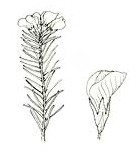Family: Fabaceae
Pultenaea viscidula
Citation:
Tate, Trans. R. Soc. S. Aust. 7:69 (1885).
Synonymy: Pultenaea viscidula Common name: Dark bush-pea.
Description:
Erect shrub to 1 m high, with pubescent branchlets which are viscid when young; leaves petiolate, narrow-linear to linear-terete, 8-14 mm long, obtuse, concave-channelled or l-furrowed above by the involute margins, glabrous above, below beset with minute basally spreading but distally antrorse hairs, often slightly tuberculate; stipules ovate-lanceolate, 0.5-1 mm long, translucent-yellow, turning blackish-brown.
Flowers 6-8 mm long, on stout erect pubescent pedicels 1.5-3 mm long, 2-6 (rarely to 13) in pseudo-umbels, forming a terminal leafy cluster sometimes proliferous; bracts absent; bracteoles inserted at the base of the calyx tube, ovate, c. 1.5 mm long, slightly keeled by the midrib, brown, leathery, sometimes with hyaline margins and ciliate, shorter than the calyx tube; calyx 4-5 mm long, reddish, pubescent, ciliate, the upper 2 lobes ovate-lanceolate, acuminate, the lower narrower, longer than the calyx tube; standard twice as long as the calyx, yellow; wings shorter, yellow; keel equalling the wings, purple; ovary villous.
Pod obliquely ovoid, c. 5 mm long, exceeding the calyx, brown, pubescent; seed ovate, c. 2.5 mm long, black.

| Pultenaea viscidula twig and flower.
|
Image source: fig 370e in Jessop J.P. & Toelken H.R. (Ed.) 1986. Flora of South Australia (4th edn).
|
|
|
Distribution:
|
S.Aust.: SL, KI.
|
Conservation status:
native
Flowering time: Sept. — Dec.
|

SA Distribution Map based
on current data relating to
specimens held in the
State Herbarium of South Australia
|
Biology:
In larger flower clusters the terminal leaves may become rudimentary, reduced to the size of a slender petiole, but the stipules are fully developed and could be mistaken for bracts.
Author:
Not yet available
|

